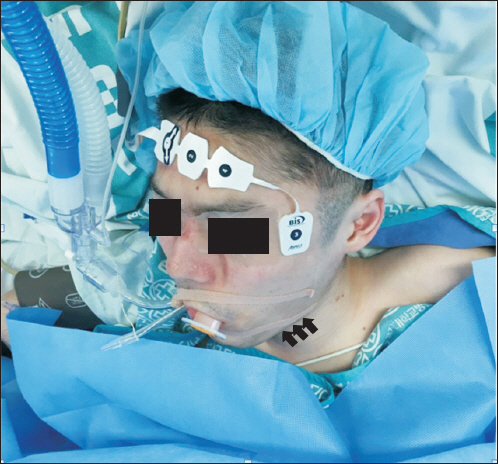Anesth Pain Med.
2018 Jan;13(1):30-33. 10.17085/apm.2018.13.1.30.
Use of remifentanil and propofol without muscle relaxant with Duchenne muscular dystrophy: A case report
- Affiliations
-
- 1Department of Anesthesiology and Pain Medicine, Eulji University Hospital, Daejeon, Korea. ryu4912@naver.com
- KMID: 2436052
- DOI: http://doi.org/10.17085/apm.2018.13.1.30
Abstract
- Duchenne muscular dystrophy (DMD) is a relatively rare muscle disease with severe symptoms. Owing to the commonly limited mouth opening, cervical spine immobility, and deformation, DMD patients often present with a difficult airway. Patients with DMD are sensitive to sedation, anesthesia, and neuromuscular blockade. This risk increases as the disease progresses with age. The anesthetic management of these patients can cause various issues, presenting a challenge to anesthesiologists. We administered anesthesia for an orchiectomy in a patient with testicular cancer using total intravenous anesthesia with propofol and remifentanil without muscle relaxants. Although the patient was Mallampati grade IV due to neck stiffness, tracheal intubation was successfully performed with a portable videolaryngoscope. The intraoperative course was uneventful and recovery was rapid without postoperative complications. In conclusion, anesthesia without a muscle relaxant was successful and the patient recovered rapidly, even with a difficult tracheal intubation.
Keyword
MeSH Terms
Figure
Reference
-
1. Muenster T, Mueller C, Forst J, Huber H, Schmitt HJ. Anaesthetic management in patients with Duchenne muscular dystrophy undergoing orthopaedic surgery: a review of 232 cases. Eur J Anaesthesiol. 2012; 29:489–94. DOI: 10.1097/EJA.0b013e3283566789. PMID: 22801582.2. Ririe DG, Shapiro F, Sethna NF. The response of patients with Duchenne's muscular dystrophy to neuromuscular blockade with vecuronium. Anesthesiology. 1998; 88:351–4. DOI: 10.1097/00000542-199802000-00013. PMID: 9477055.3. Wick S, Muenster T, Schmidt J, Forst J, Schmitt HJ. Onset and duration of rocuronium-induced neuromuscular blockade in patients with Duchenne muscular dystrophy. Anesthesiology. 2005; 102:915–9. DOI: 10.1097/00000542-200505000-00009. PMID: 15851877.4. Ramachandran SK, Mathis MR, Tremper KK, Shanks AM, Kheterpal S. Predictors and clinical outcomes from failed Laryngeal Mask Airway Unique™: a study of 15,795 patients. Anesthesiology. 2012; 116:1217–26. DOI: 10.1097/ALN.0b013e318255e6ab. PMID: 22510864.5. Boland BJ, Silbert PL, Groover RV, Wollan PC, Silverstein MD. Skeletal, cardiac, and smooth muscle failure in Duchenne muscular dystrophy. Pediatr Neurol. 1996; 14:7–12. DOI: 10.1016/0887-8994(95)00251-0.6. Segura LG, Lorenz JD, Weingarten TN, Scavonetto F, Bojanić K, Selcen D, et al. Anesthesia and Duchenne or Becker muscular dystrophy: review of 117 anesthetic exposures. Paediatr Anaesth. 2013; 23:855–64. DOI: 10.1111/pan.12248. PMID: 23919455.7. Shin HH, Park DH, Lee C, Woo SC, Kim YJ, Joo JH, et al. Anesthesia for a 10-year-old boy with Duchenne muscular dystrophy syndrome: a case report. Korean J Anesthesiol. 2008; 55:217–20. DOI: 10.4097/kjae.2008.55.2.217.8. Frankowski GA, Johnson JO, Tobias JD. Rapacuronium administration to two children with Duchenne's muscular dystrophy. Anesth Analg. 2000; 91:27–8. DOI: 10.1213/00000539-200007000-00005. PMID: 10866881.9. Buzello W, Krieg N, Schlickewei A. Hazards of neostigmine in patients with neuromuscular disorders. Report of two cases. Br J Anaesth. 1982; 54:529–34. DOI: 10.1093/bja/54.5.529. PMID: 7073921.10. Schmidt J, Muenster T, Wick S, Forst J, Schmitt HJ. Onset and duration of mivacurium-induced neuromuscular block in patients with Duchenne muscular dystrophy. Br J Anaesth. 2005; 95:769–72. DOI: 10.1093/bja/aei249. PMID: 16183677.11. Capozzoli G, Auricchio F, Accinelli G. Total intravenous anaesthesia without muscle relaxants in a child with diagnosed Duchenne muscular dystrophy. Minerva Anestesiol. 2000; 66:839–40. PMID: 11213553.12. Cossu F, Caboni MT. Propofol in Duchenne muscular dystrophy. Minerva Anestesiol. 1995; 61:51–3. PMID: 7617241.13. Kim JE, Chun HR. Rocuronium-induced neuromuscular block and sugammadex in pediatric patient with duchenne muscular dystrophy: a case Report. Medicine (Baltimore). 2017; 96:e6456. DOI: 10.1097/MD.0000000000006456. PMID: 28353578. PMCID: PMC5380262.14. Wefki Abdelgawwad Shousha AA, Sanfilippo M, Sabba A, Pinchera P. Sugammadex and reversal of neuromuscular block in adult patient with duchenne muscular dystrophy. Case Rep Anesthesiol. 2014; 2014:680568. DOI: 10.1155/2014/680568.
- Full Text Links
- Actions
-
Cited
- CITED
-
- Close
- Share
- Similar articles
-
- A clinical study on Duchenne muscular dystrophy
- Acute Gastric Dilatation and Calculous Cholecystitis in Duchenne's Muscular Dystrophy
- Total Intravenous Anesthesia using Bispectral Index for Transvaginal Uterine Myomectomy in a Patient with Myotonic Dystrophy: A case report
- Duchenne Type Muscular Dystrophy: Report of 8 Cases
- Anesthesia for a 10-year-old boy with Duchenne muscular dystrophy syndrome: A case report


